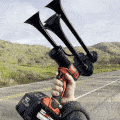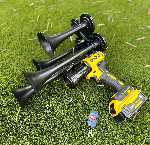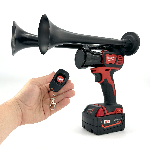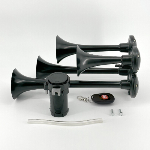Did you know that there is a unique instrument capable of producing a piercing sound that can be heard from a long distance away? This instrument, originally utilized as a signal device in maritime settings, has evolved into a versatile tool with various applications in our modern world.
Originating in the late 19th century, the air horn instrument was initially employed on ships to communicate sounds over long distances. It became an indispensible tool for maritime safety, warning vessels of potential dangers and effectively conveying urgent messages. Over time, this ingenious invention found its way into other industries, proving to be essential in railway and automotive settings as well.
With its powerful sound projection and ability to cut through ambient noise, the air horn instrument has become a safety device in many sectors. In the transportation industry, it is widely used on trains and trucks to alert pedestrians and motorists of their presence, thus mitigating the risk of accidents. Additionally, these instruments serve as an effective means of communication and signal enforcement on construction sites and in factories, ensuring workers can be promptly alerted in case of emergencies.
Interestingly, studies have shown that the loud and attention-grabbing nature of air horns can help deter wildlife from roads, reducing the likelihood of collisions between vehicles and animals. This innovative solution has been particularly effective in areas where wildlife crossings are common, contributing to the conservation of various species.
The air horn instrument has come a long way since its inception and continues to play a vital role in our daily lives. From maritime signal devices to essential safety tools, these instruments have proved their worth in a variety of settings. Their ability to produce a loud and attention-grabbing sound has made them not only valuable for safety purposes, but also for the protection of wildlife and the prevention of accidents.
What is an air horn instrument and how does it work?
History of Air Horns
Air horns have a long history that dates back to the early 19th century. The first air horns were developed as a means of communication in the shipping industry. They were used to signal warnings, communicate with other ships, and announce arrivals or departures.
Over time, air horns found their way into various other industries and purposes. They became popular in sporting events, where they were used to cheer on teams or create a festive atmosphere. Air horns were also widely adopted in the automotive industry as a safety measure. They are commonly used on large trucks and trains to alert pedestrians and other vehicles of their presence.
How Air Horns Work
Air horns function based on a simple yet effective principle. The horn consists of a pressurized air canister and a reed or diaphragm. When the horn is activated, air is forced into the canister, and the reed or diaphragm begins to vibrate rapidly. The resulting sound waves are amplified by the horn's shape, creating a loud and distinctive noise.
The pitch and tone of an air horn can be adjusted by altering the length and shape of the horn itself. Shorter horns produce higher-pitched sounds, while longer horns create deeper tones. Additionally, some air horns may feature multiple reeds or diaphragms, allowing for more complex and layered sounds.
Uses of Air Horns
Air horns have a wide range of applications in various industries and settings. In the maritime industry, they are still used as a means of communication between ships. They are also employed in emergency situations to signal distress or warn of impending danger.
In sporting events, air horns are a staple for fans to show their support and enthusiasm. They create an exciting and energetic atmosphere, particularly in team sports such as football or basketball. Additionally, air horns are often used in motor racing events to signify the start or end of a race.
The automotive industry extensively utilizes air horns for safety purposes. They are commonly found on commercial trucks, buses, and trains to alert pedestrians and other vehicles of their presence. Air horns are also popular among car enthusiasts who want to upgrade their stock horns for a louder and more attention-grabbing sound.
Controversies Surrounding Air Horns
Despite their widespread use, air horns have attracted some controversy in recent years. They can be incredibly loud, reaching decibel levels that are harmful to human hearing. Misuse or excessive use of air horns can cause discomfort, annoyance, and even permanent hearing damage.
Some countries and municipalities have implemented regulations or outright bans on air horns in certain settings, such as residential areas or public events. Additionally, there have been instances of misuse of air horns as a form of harassment or disruption of public peace.
Statistics
- According to a study by the World Health Organization, exposure to continuous noise levels above 85 decibels can lead to hearing damage.
- In 2019, the city of Sydney, Australia, introduced fines for motorists using excessively loud air horns, with penalties of up to $550 AUD.
- A survey conducted by the National Institute for Occupational Safety and Health found that prolonged exposure to air horns in industrial settings can lead to hearing loss in workers.
https://youtube.com/watch?v=BWP8AMofZqs
Frequently Asked Questions about a Noisemaking Device
1. What purposes does this device serve?
The versatile sound-producing apparatus can be used for various reasons and in different settings. Whether you are attending a sporting event, expressing enthusiasm during a music concert, or wishing to draw attention in an emergency situation, this device can effectively achieve your goal.
- This device is commonly used in sporting events, music concerts, and emergencies.
- It can be used to express enthusiasm and draw attention.
- The device is versatile and can serve different purposes.
2. How does this instrument work?
This instrument operates by utilizing compressed air or gas, which creates a loud and distinct sound when forcefully expelled. By activating a valve or button, the user can release the compressed air, resulting in a powerful noise that is instantly recognizable.
- The instrument operates by using compressed air or gas.
- Expelling the compressed air creates a distinctive sound.
- Activating a valve or button releases the compressed air.
3. How loud is this noisemaking device?
The decibel level of this instrument can vary depending on different factors, such as the design and the pressure of the air or gas used. Generally, these devices produce a sound level ranging from 90 to 120 decibels, which is comparable to the noise produced by a chainsaw or a thunderclap.
- The decibel level of this device can range from 90 to 120 decibels.
- It produces a sound level comparable to that of a chainsaw or thunderclap.
- Various factors, such as design and pressure, impact the loudness of the instrument.
4. Are there any safety precautions when using this instrument?
While having fun with this instrument is important, ensuring everyone's safety is equally crucial. When using this device, it is advisable to maintain a safe distance from others to avoid potential hearing damage. Additionally, one should use the instrument cautiously and responsibly, as the loud sound produced may startle or disturb those around.
- Maintain a safe distance from others when using the instrument.
- Use the instrument cautiously and responsibly to avoid startling or disturbing others.
- Be mindful of potential hearing damage when exposed to the loud sound.
5. Are there any regulations regarding the use of this noisemaking device?
In some regions, there may be laws or regulations that govern the use of this instrument to ensure public safety and prevent disturbance. It is essential to familiarize yourself with local laws or venue policies before using this device in public spaces. Being aware of the rules and regulations will help you enjoy the use of this instrument responsibly and without consequences.
- Familiarize yourself with local laws or venue policies regarding the use of the instrument.
- Some regions have regulations in place to ensure public safety and minimize disturbance.
- Adhering to rules and regulations allows for responsible and enjoyable use of the device.
In conclusion, this frequently asked questions section has provided essential information about a versatile sound-producing instrument. The device can be used for various purposes, operates by utilizing compressed air or gas, produces a loud sound, requires safety precautions for responsible use, and may be subject to regional regulations for public safety. Whether you are a sports fan wanting to cheer on your team, a concert-goer seeking an immersive experience, or an individual concerned about safety during emergencies, this instrument can cater to your needs while ensuring an enjoyable and responsible usage experience.
Conclusion
In conclusion, the air horn instrument is a unique and versatile tool with a variety of uses. It is commonly used in sporting events, concerts, and clubs to create a loud and attention-grabbing sound. The air horn's loud and piercing noise is perfect for signaling, alerting, and adding excitement to various situations.
One key advantage of the air horn instrument is its simplicity and ease of use. It operates on compressed air, which means no electricity or special skills are required to play it. Additionally, it can be easily transported and used in various settings due to its portable nature.
The air horn is commonly used in sports events to energize and motivate both players and fans. Its loud sound can boost team spirit, create enthusiasm, and generate excitement among the crowd. Furthermore, in emergency situations, the air horn's loud and distinctive sound can be used as a signaling device to attract attention and indicate danger.
Another area where the air horn instrument is widely used is in musical performances. It can be found in various genres of music, including hip-hop, reggae, and dancehall. In these contexts, it is often used to create sound effects, add intensity to a performance, or emphasize certain beats or musical transitions.
While the air horn is a versatile instrument, it is essential to use it responsibly and considerately. Its powerful sound can be disruptive and irritating if used unnecessarily or inappropriately. Therefore, it is important to use it in a controlled and mindful manner, respecting others' comfort and noise regulations.
In conclusion, the air horn instrument has proven to be an impactful and attention-grabbing tool in a variety of settings. Its loud and distinctive sound can be used to energize, alert, and entertain. When used responsibly, the air horn adds an exciting and memorable dimension to sporting events, concerts, and musical performances.










 https://bosshorn.com
https://bosshorn.com

























































